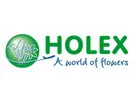Chinese New Year is the most busy period for flower sellers. This year, the Chinese New Year started on January 28th. In this article, Katherine Young, General Manager of Holex Shanghai, shared insights about the market performance of imported flowers in China during the Chinese New Year.
Together with Robin de Vos, they set up the Holex China office in 2018. "Each year, from October to March, is our most important period. It includes major events such as Chinese New Year, the peak wedding season, Valentine's Day, and Women's Day."
"2024 was a challenging year for the flower industry, affecting both domestic and imported flowers. The period from 2018 to 2023 was the peak for imported flowers. For example, Ilex verticillata was among the most popular imports, but with massive local production in Yunnan and Shandong, its imported quantity has dropped by 90% annually."
"With an uncertain market, wholesalers are now more careful. Instead of storage, presale is more common. People come to us when they get a pre-order, which requires us to have strong logistics skills. Thanks to the rich resources, experience, and expertise of the Holex Group and Dutch Flower Group, we consistently meet these demands."
As their customers are everywhere in China, they also noticed that wholesalers from first-tier cities Zhejiang, and Shanghai pay more attention to quality; "Wholesalers from Kunming are more quantity-driven relatively."
"The tulip is the king in all imported categories, with pink and white varieties being especially popular. The performance of Protea cynaroides from South Africa is good and another popular flower is Forsythia suspensa. The number of imported roses however decreased significantly, one of the reasons is the improved quantity of the domestic crops."
Market fluctuations are inevitable. Although local flower production in China has increased and improved, some imported varieties still hold a place in the market due to their superior quality. Allium giganteum, calla lily, Vanda, and commercially grown cut phalaenopsis still have markets. For instance, commercially grown cut phalaenopsis with brown color is very special, which has a niche market and only focuses on high-value customers.

"Although people complain that it's not easy to sell flowers, personal consumption is still increasing. Flowers are becoming a normal good in daily life. Among these, digital selling plays a key role here. Except for traditional wholesalers, more parties are entering the industry. China's online selling platforms such as Hema, JingDong, and Dindong started to sell flowers, which have well-organized logistics and can deliver goods to customers fast. Meanwhile, influencers who are active in TikTok, and Rednote help to promote new variety quickly. However, the market still faces challenges, including a lack of standardized quality control and price variability,"
A significant trend is that more Chinese farms are looking for overseas buyers. "Japan, Vietnam, and Thailand are traditional exporting destinations, and now, the Middle-East, and Russia are hot topics. We are also setting up an office in Kunming which is for exportation. "
 For more information:
For more information:
Robin de Vos
GM Holex Kunming
Robin.de.vos@holex.com
www.holex.com
